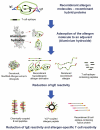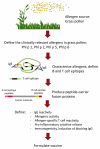Vaccine development for allergen-specific immunotherapy based on recombinant allergens and synthetic allergen peptides: Lessons from the past and novel mechanisms of action for the future
- PMID: 26853127
- PMCID: PMC4861208
- DOI: 10.1016/j.jaci.2015.12.1299
Vaccine development for allergen-specific immunotherapy based on recombinant allergens and synthetic allergen peptides: Lessons from the past and novel mechanisms of action for the future
Abstract
In the past, the development of more effective, safe, convenient, broadly applicable, and easy to manufacture vaccines for allergen-specific immunotherapy (AIT) has been limited by the poor quality of natural allergen extracts. Progress made in the field of molecular allergen characterization has now made it possible to produce defined vaccines for AIT and eventually for preventive allergy vaccination based on recombinant DNA technology and synthetic peptide chemistry. Here we review the characteristics of recombinant and synthetic allergy vaccines that have reached clinical evaluation and discuss how molecular vaccine approaches can make AIT more safe and effective and thus more convenient. Furthermore, we discuss how new technologies can facilitate the reproducible manufacturing of vaccines of pharmaceutical grade for inhalant, food, and venom allergens. Allergy vaccines in clinical trials based on recombinant allergens, recombinant allergen derivatives, and synthetic peptides allow us to target selectively different immune mechanisms, and certain of those show features that might make them applicable not only for therapeutic but also for prophylactic vaccination.
Keywords: Allergy; allergen; allergen-specific immunotherapy; allergy vaccine; preventive allergy vaccine.
Copyright © 2015 The Authors. Published by Elsevier Inc. All rights reserved.
Figures
Similar articles
-
Preventive Allergen-Specific Vaccination Against Allergy: Mission Possible?Front Immunol. 2020 Jul 7;11:1368. doi: 10.3389/fimmu.2020.01368. eCollection 2020. Front Immunol. 2020. PMID: 32733455 Free PMC article. Review.
-
Recombinant allergy vaccines based on allergen-derived B cell epitopes.Immunol Lett. 2017 Sep;189:19-26. doi: 10.1016/j.imlet.2017.04.015. Epub 2017 May 1. Immunol Lett. 2017. PMID: 28472641 Free PMC article. Review.
-
Novel vaccines for allergen-specific immunotherapy.Curr Opin Allergy Clin Immunol. 2021 Feb 1;21(1):86-99. doi: 10.1097/ACI.0000000000000706. Curr Opin Allergy Clin Immunol. 2021. PMID: 33369572 Free PMC article. Review.
-
Developments in allergen-specific immunotherapy: from allergen extracts to allergy vaccines bypassing allergen-specific immunoglobulin E and T cell reactivity.Clin Exp Allergy. 2010 Mar;40(3):385-97. doi: 10.1111/j.1365-2222.2009.03443.x. Clin Exp Allergy. 2010. PMID: 20210812
-
Recombinant allergens for immunotherapy: state of the art.Curr Opin Allergy Clin Immunol. 2019 Aug;19(4):402-414. doi: 10.1097/ACI.0000000000000536. Curr Opin Allergy Clin Immunol. 2019. PMID: 31082821 Free PMC article. Review.
Cited by
-
IgG in the control of FcεRI activation: a battle on multiple fronts.Front Immunol. 2024 Jan 11;14:1339171. doi: 10.3389/fimmu.2023.1339171. eCollection 2023. Front Immunol. 2024. PMID: 38274816 Free PMC article. Review.
-
Studies on HBcAg-rBlo t 5-21 Fusion Protein Vaccine That Alleviates Blomia tropicalis Airway Inflammation.J Inflamm Res. 2022 Nov 18;15:6343-6355. doi: 10.2147/JIR.S380526. eCollection 2022. J Inflamm Res. 2022. PMID: 36424919 Free PMC article.
-
Utility and Comparative Efficacy of Recombinant Allergens Versus Allergen Extract.Curr Allergy Asthma Rep. 2017 Aug 18;17(9):63. doi: 10.1007/s11882-017-0727-9. Curr Allergy Asthma Rep. 2017. PMID: 28822054 Review.
-
Adjuvants for allergy immunotherapeutics.Hum Vaccin Immunother. 2017 Oct 3;13(10):2416-2427. doi: 10.1080/21645515.2017.1348447. Hum Vaccin Immunother. 2017. PMID: 28825867 Free PMC article. Review.
-
Clustering of conformational IgE epitopes on the major dog allergen Can f 1.Sci Rep. 2017 Sep 22;7(1):12135. doi: 10.1038/s41598-017-11672-5. Sci Rep. 2017. PMID: 28939849 Free PMC article.
References
-
- Noon L. Prophylactic inoculation against hay fever. Lancet. 1911;1:1572–3.
-
- Dunbar WP. Zur Frage betreffend die Ätiologie und spezifische Therapie des Heufiebers. Berliner klin. Wochenschr. 1903;24:6.
-
- Larche M, Akdis CA, Valenta R. Immunological mechanisms of allergen-specific immunotherapy. Nat Rev Immunol. 2006;6:761–71. - PubMed
-
- Bousquet J, Lockey R, Malling HJ. Allergen immunotherapy: therapeutic vaccines for allergic diseases. A WHO position paper. J Allergy Clin Immunol. 1998;102:558–62. - PubMed
Publication types
MeSH terms
Substances
Grants and funding
LinkOut - more resources
Full Text Sources
Other Literature Sources
Medical
Miscellaneous




